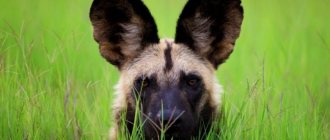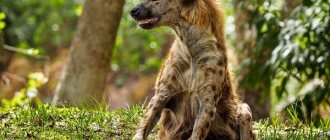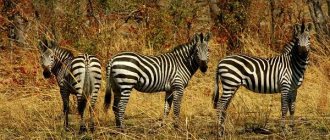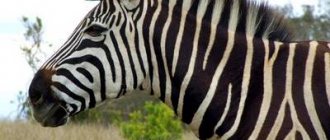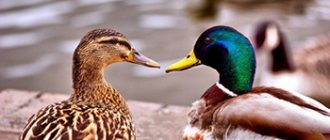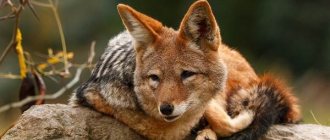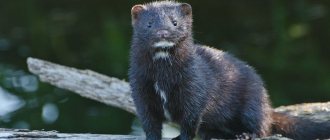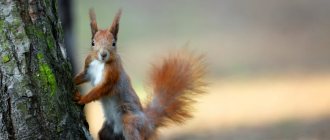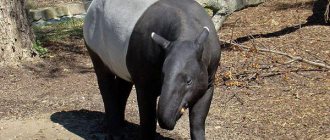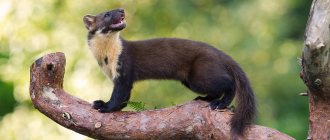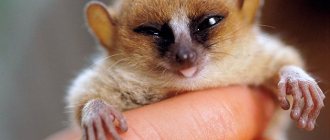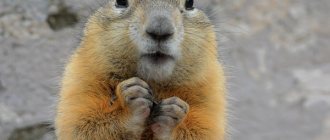Hyena (lat. Hyaenidae) is a wild mammal that is similar in appearance to a dog or wolf. Hyena family, suborder Felidae, order Carnivora. If translated from Latin, the name can be translated as pig or wild boar. This is due to the physiological characteristics of hyenas, namely the bristly back and the unpleasant odor that these animals emit.
Where do hyenas live?
African animals include a mammal that inspires fear in many safari visitors. Open areas are an ideal place for a pack of hyenas to settle.
It is noteworthy that these animals choose places with a cool climate, and like dogs, they mark the territory on which they build their home. In addition, this representative of the cat family puts a representative from the pack on guard when roosting for the night, to protect the family.
The hyena is mistakenly classified as a member of the canine family. In fact, it belongs to the cat family.
The hyena is largely a nocturnal animal. During the day, the flocks sleep off from night hunts or transitions. Although they do not like to change their territory too much, they occasionally have to do this to find places with a lot of food.
Nutrition
When we say that a hyena is a scavenger , we wrinkle our nose in disgust. Meanwhile, she is an excellent hunter; moreover, her menu consists of up to 90% of live prey. Only she wisely supplements her diet. In fact, this animal saves nature from pollution, is the orderly of the fauna and maintains balance among other animals.
They hunt in packs large ungulates - zebras, gazelles, wildebeests, and can even hunt down buffalo. They can attack a sick predator, a lion, for example. A large female alone can knock down an antelope. Sometimes they even attack rhinoceroses and hippopotamuses. Mammals, birds, reptiles and their eggs come to them for lunch.
They are also not shy about eating after other animals. Everything that is left after eating another predator - bones, hooves, wool - all this is processed in an “animal waste factory” called “hyena”.
Her digestive tract is designed in such a way that she digests and assimilates almost everything. And the most powerful jaws among predatory mammals help grind hard objects. The pressure of these jaws can reach 70 kg/sq.cm
Features of behavior
There is a misconception that this mammal is a dangerous animal. This opinion is based on the fact that they kill innocents and also feed on carrion. In fact, there are much more dangerous creatures in nature, and thanks to man’s ability to tame and train, even domestic hyenas can be found. At the same time, they become your best friend at home. If an animal comes to a meeting and begins to trust a person, then in terms of devotion it is in no way inferior to an ordinary dog.
Nature has endowed the nimble predator with abilities that seem surprising at first glance. For example, they are capable of producing peculiar sounds. With a devilish laugh, the hyena notifies its family about the discovery of a large amount of food. But animals such as lions have learned to recognize these urges. Often lions take food from hyenas. A pack of predators is unable to fight such a serious opponent and retreats. And they have no choice but to eat up the leftovers or look for a new place for lunch.
In addition, nature endowed the ends of the animal’s paws with glands. By the specific smell of the secretion produced, the “hunters” learned to identify individuals of their flock. This allows them to identify and scare away an intruder.
The hyena is not a terrible animal. In fact, they perform a very important role by eating carrion - they serve as orderlies. At the same time, hunting other animals ensures the equality of the animal world.
Lifestyle
Spotted hyenas are crepuscular animals . The greatest activity occurs from 18:00 to 09:00, but the animals do not show constant activity. Females are generally less active than males, although over a 24-hour period both sexes spend between 65% (males) and 75% (females) resting. The overall breakdown of activity is: resting - 69%, hunting - 23%, feeding - 5% and socializing - 3%.
Photo: Birger Strahl
During the day, hyenas rest in dense bushes, tall grass, rock crevices, dens or natural depressions. They largely modify earthen burrows originally dug by other animals such as aardvarks and warthogs; Moreover, warthogs can share burrows with spotted hyenas.
Burrows, 1.5 to 3 meters long, are often oval in shape with entrances up to 1 meter in diameter, but sometimes less than 25 cm. Dens are replaced monthly, but can be reused for many years.
Spotted hyenas set up a den at a distance of up to 30+ km from fresh water . When water is scarce, they rely on the fluids in the prey they eat.
Behavior of hyenas in a pack
Matriarchy reigns in a pack of predators. The hierarchy is built according to the following principles:
- The older females are the most important. They are given the greatest privileges: to rest in the coolest place in the hole, to be the first to taste lunch. In turn, they bear and raise the largest number of offspring.
- Low class females. They follow the elders, that is, they start eating in the second place and rest away from the elders.
- Males. They belong to the lowest class.
general description
Hyenas are one of the unusual and interesting animals that can be found in the steppes, foothills of the African continent, and savannas. Because of their appearance and behavioral characteristics, many people treat them with disdain. However, these animals are orderlies for the desert regions of Africa, savannahs, foothills, and plains. They maintain the natural balance in nature by hunting small animals and destroying the remains of other living beings.
Types of hyenas
In nature, there are 4 following types of hyenas:
- spotted;
- striped;
- brown;
- aardwolf.
It is worth noting that the largest of this cat family is the striped hyena. The smallest species is the aardwolf. The striped hyena is the only species of hyena found outside of Africa.
In addition to ordinary hyenas, animals such as hyena dogs live in the vastness of Africa. Between these species, when meeting, there are always massacres for territory. The family with the most animals wins. In addition to dog hyenas, there are quite a few other enemies in the wild. The most feared is the lion.
spotted hyena
The spotted hyena resembles a large dog like no other. She has a powerful and wide head, her eyes are not deep set. The ears are rounded and not large. The fur is much shorter than that of other species. With the onset of old age, this predator loses 50 percent of its fur. Has a tail of impressive size. Another distinctive feature is the presence of coarse long hair from the withers to the tail. Visually, this fur forms a mane.
This representative has very sharp and strong teeth. It is believed that the jaw of this species is one of the strongest among all mammals. The animal is capable of reaching speeds of up to 65 km/h. If you look at him in profile, you may notice a slight hump on his back.
Outwardly, it is quite difficult to distinguish a female from a male. No matter how strange it may sound, their organs are very similar. It is possible to accurately determine the sex only of a lactating female. She has a clearly visible pair of nipples, which are located near her hind legs.
The spotted mammal can have a variety of colors. It varies from light sand to brown. A distinctive feature is round dark spots all over the body. The tail of the predator is fluffy and decorated with dark rings, the tip is black.
This species makes more than 11 sounds, several of them prolonged. If you hear the howl of this hyena from afar, you can confuse it with loud laughter.
The spotted hyena is the largest representative of its family. The body length ranges from 100 to 166 centimeters, and the average weight is 75 kilograms.
In nature, this species lives for about 20-25 years.
Striped hyena
The striped hyena is a fairly large subspecies of the family, the weight of an adult individual is about 60 kilograms. Males are always much larger than females. The upper part is covered with coarse long hair that forms a mane. The remaining hair barely grows 7 centimeters. There are pronounced stripes throughout the body. Hence the name of the subspecies.
Their paws are very curved, with the front ones being longer than the back ones. If you see this predator from afar, you might think that it is injured.
The body of this representative is not massive. The neck is short but thick. The head is large with a heavy lower jaw. The ears are pointed towards the top.
Basically, this species only growls and howls. They make virtually no other sounds.
The spotted hyena feeds mainly on carrion. Although in the first years of life it loves to eat vegetation.
In captivity, this species lives for about 40 years.
Brown hyena
Outwardly, the brown hyena resembles an ordinary medium-sized dog. In this species, the body is raised at the withers and externally, you can see a small hump. The head is large and set on a thick neck. Their ears are the largest compared to individuals of other subspecies. The legs are curved, but quite strong. The tail is large and shaggy.
The brown hyena is one of the smallest representatives of the family. Its weight is about 35 kilograms, although its body length is about 70 centimeters.
There is little hair on the body of this individual. All wool is very hard and dark brown in color. Sometimes you can find a representative with a gray tint. The jaw is equipped with sharp teeth that can easily crush even bones.
An interesting feature is that this predator turns gray with age.
Males and females are very similar. Externally, it is almost impossible to find distinctive features. The only peculiarity is the sounds made and the attitude in the pack. If the female makes a sound, then the rest of the family gathers around her. If a male howls, it goes unnoticed.
In nature, it lives for about 20 years.
Aardwolf
The aardwolf is a hyena that lives in Africa. Outwardly similar to the striped hyena, but it is difficult to confuse them. The aardwolf weighs up to 14 kilograms and the body length without tail is about 55 centimeters. This is the only species in which sexual dimorphism is not observed, so outwardly it is very difficult to distinguish a female from a male.
The muzzle of this species of hyena is similar to that of a dog, but it is very small, one might even say elongated. The paws are high and not massive. The coat is thick and not harsh. Inside there is soft, light-colored down. In case of danger, the aardwolf's mane stands on end. Thus, the individual warns the flock.
The hyena of this subspecies can have several colors. Color varies from sand to brown. A distinctive feature is pronounced stripes throughout the body.
An interesting feature of the aardwolf is the presence of 5 fingers on the forelimbs.
The entire jaw is equipped with sharp teeth. The fangs are especially large and long. With them, a hyena can tear apart an enemy many times larger than itself.
African hyena
The African hyena is a large predator. Her average weight is 70-80 kilograms. Outwardly it looks like a large dog, but with a small head. The muzzle is outwardly elongated, with 2 small round ears set on top. This hyena looks rather awkward.
The color is usually yellowish. The whole body is covered with dark spots. The fur reaches a length of 5-7 centimeters. Hair of increased rigidity grows from the withers to the tail. Externally, this hair forms a mane.
The front legs of this subspecies are longer than the hind legs, so it may appear that the hyena is limping.
This species mainly feeds on carrion, but can sometimes attack zebras and antelopes. The character is hot-tempered. It can even attack a person.
This species has pronounced sexual dimorphism. There are no external differences between females and males.
The only significant opponent of the African hyena is the lion.
Lifestyle and habitat
The most free and comfortable conditions in which the hyena lives are the savannas of Africa. They live in open desert grassy areas called the savanna belt. They stay close to the edges of small forests, next to bushes and single trees.
The year in such places is divided into 2 seasons - summer and autumn. The climate here is either very dry or very rainy. There is no average. The African world is full of predators worse than our heroine. Therefore, they are often forced to flock together in order to protect their prey.
A pack of hyenas is always close to food, they are voracious and insatiable. They accompany a large and hearty lunch with their famous laughter, but this attracts lions. They already know that at this moment the hyenas have prey. So it turns out that she needs to eat everything as quickly as possible. Hence the greed in food.
It is not for nothing that the confrontation between the hyena and the lion is often mentioned. These two animals usually live close to each other, share the same food territory and compete with each other. Moreover, victory occurs alternately for both sides.
Contrary to popular belief, it is not hyenas who take prey from lions, but vice versa. The luckier, faster and more determined hyenas are more likely to make a profit. Several lionesses are able to cope with them and take the victim. The signal for an attack is the cry of a hyena.
They try to mark their territory with odorous substances to scare away unwanted raiders, but this does not always help. Sometimes they change their location and go to another place. Usually due to lack of food. Hyena is a nocturnal animal. Hunts at night, rests during the day.
This animal is hardy, despite its external awkwardness. It develops high speed when running away from an enemy or hunting. The speed of a hyena can reach 65-70 km/hour. Moreover, she calmly runs long distances.
They have glands on their paws that emit odor. Each hyena has its own. This is how they get to know each other. In a pack of hyenas, there is usually a hierarchy, like all animals. However, each of them is trying to take a place at the tastiest piece.
Reproduction of hyenas in nature
To continue procreation and conceive cubs, the female hyena prepares for a year. Pre-mating of hyenas occurs once every two weeks. While the male reproductive organs are ready for fertilization in certain seasons.
The genital organs of a hyena are unique in their structure. An inexperienced person will not be able to distinguish whether the hyena in front of him is a female or a male. In the female hyena, the clitoris, under which the scrotum is located, is identical to the male's penis. Mating of two individuals occurs by penetration of the penis through the clitoris into the genitourinary canal.
Male hyenas fight in front of the female to reproduce. The winner, lowering his head and tail, approaches the female, and with her permission, the offspring are conceived.
Spread range
sub-Saharan Africa , excluding the rainforests of the Congo Basin and much of southern Africa, i.e. approximately 17° to 28° S latitude.
Photo: Wikipedia
Spotted hyenas live in a variety of habitats from dry and arid semi-deserts to savannas and swamps. They can be found from the snowy edge of Kilimanjaro to 4000 meters above sea level .
- Biogeographic regions: Ethiopian (native)
- Habitat: tropical
- Terrestrial biomes: semi-desert, savanna or grassland, shrub forest, mountains
Home range
Population density varies widely, from 0.004 to 1.65 individuals per square kilometer. The lowest density is found in the Namib Desert, Namibia, and the highest in Amboseli National Park and Ngorogoro Crater, Tanzania. Clan territories in the Namib Desert range from 383 to 816 square kilometers. km. One clan in the Kruger National Park had a territory of 130 square meters. km, but individual representatives of this clan were located on an area of 9-16 square meters. km. In general, the clan's home ranges range from 13 to 1065 square meters. km .
Hyena cubs
The first hyena cub is born one hundred and ten days after conception. At the same time, an animal can give birth to up to three puppies at a time. A representative of felines, in order to continue the family, sets up a separate hole.
Hyenas are born immediately with their eyes open and weighing about two kilograms. The creature feeds its offspring with breast milk for a year and a half.
The color of the cub is brown. With age, the color changes and becomes darker. An interesting feature in the life of a hyena is that children occupy the status in the pack that their parents held. Such a kind of legacy. The maximum age of hyenas is about twelve years.
What age the animal has reached can be determined based on its color. The darker the color, the older the animal. The main color of the coat is yellowish-brown, with dark gray spots, like a leopard. The hyena's head is uniformly brown, but its muzzle is distinctly black. In addition, a burgundy tint is observed on the back of the head.
Scientific classification
- Kingdom: Animalia (animals)
- Phylum: Chordata
- Class: Mammalia (mammals)
- Order: Carnivora (predatory)
- Family: Hyaenidae (hyenas)
- Genus: Crocuta (spotted hyenas)
- Species: Crocuta crocuta (spotted hyena)
Crocuta is a Latinized version of the Greek "krokúttas" or "krokottas", which itself comes from a Sanskrit word meaning "female golden jackal". Ancient texts often refer to any of the three types of hyenas as jackals. The first mention of the genus Crocuta dates back to 1681. Another common name for spotted hyena in English is tiger wolf.
Hunting
To catch prey, nature has endowed hyenas with short hind legs and long front legs, which allows them to develop enormous speed and cover fairly long distances without stopping.
As a hunter, the animal is far superior in skill to lions. They hunt mainly at night, covering more than seventy kilometers. When hunting, the mammal simply exhausts its prey by running long distances. At the same time, frightening her with a devilish laugh, turning into a howl. When the victim is unable to escape, they bite her legs, thereby completely immobilizing her. They eat their prey alive, and not, like other hunters, pre-suffocate it.
Their hearing, smell and vision are at the highest level. For example, they smell carrion at a distance of more than four kilometers.
Social structure
The hyena clan is pursuing the lioness.
The hyena clan is a formidable force. When there are many of them, they become very bold and decisive, even attacking groups of lions and taking away their “legitimate” prey. True, this usually happens if there is no adult male or several males among the lions. It also happens the other way around, when lions take away an animal they have recently caught from hyenas.
Hyenas “deal” with other African predators relatively easily. Even one hyena can take prey from a leopard and easily drive away a cheetah. Only a pack of hyena dogs can resist hyenas, and even then only with numerical superiority.
Interesting: Interesting facts about water, photos and videos
What does a hyena eat?
The animal feeds mainly on animals it catches while hunting. Moreover, the size of the prey can be many times greater than the size of the hunter himself. Although such food provides the body with much more nutrients and useful substances, the predator does not hesitate to feast on carrion.
If the flock has not found animal food, then it goes looking for plant food. Individuals can eat juicy grass and even fruits with great pleasure. This way the hyena will never go hungry!
Oddly enough, but alone hyenas are very cowardly. Therefore, hyenas often hunt in packs, making them very difficult for another animal to defeat.
Hyenas have a unique digestive system. Thanks to it, these creatures easily digest bone, horns, hooves and wool. Within a day, the stomach of these animals is able to digest everything eaten.
Interesting Facts
- Hyenas are very fond of succulent plants, they especially like watermelons and melons. For their sake, they raid the melons . They enjoy eating nuts and seeds.
- Hyenas confirm their relationship with the cat family by “social laws” in the pack. They are more likely not a pack, but a pride, similar to a lion. There is a royal hierarchy and power by inheritance. Only they have a matriarchy. And everyone is led by the main female hyena, the queen. Sometimes she can be overthrown, but this happens extremely rarely.
- If a member of the pride gets sick or is injured, the rest of his relatives never abandon him and take care of him by bringing him food.
- Communication by laughter is actually a signal from the main female to accept food from the next individual in the hierarchy. So they avoid conflicts and fights due to unnecessary haste.
- Another way of communication is a pungent smell. They mark and limit space with it, show their moral, physical condition and readiness to start a family.
- Hyenas are highly trainable. They are intuitively able to perceive a person as an owner.
Domestic hyena, how to keep a hyena at home?
If a person decides to have such an exotic animal as a hyena at home, then first you need to take care of safety. It is not recommended to have such an animal in an apartment; the best option would be a country house. In this case, it is necessary to build an enclosure with strong metal rods. When determining the location for the enclosure, it is necessary to take into account the hyenas' habitat. They like coolness, but not cold.
It is best to opt for a baby rather than an adult. Since the cubs are more amenable to training and have not yet had time to get used to the wild habitat. As mentioned earlier, hyenas easily make contact with humans, but only if they have gained trust. In order for a predator to recognize a person as a friend, it is not necessary to constantly keep it in an enclosure. Still, this is a wild animal and it needs freedom.
It is recommended to feed this cat dry food. Meat should be given very rarely and in small portions. It is worth noting that after eating meat, an animal, even one raised at home, instinctively becomes aggressive. Your pet should include vegetables and fruits in their diet as often as possible. They will fill the body with vitamins and minerals and make the coat thicker.
It is necessary to treat such a pet with affection and love, and then he will reciprocate.
Fossils
The ancestors of spotted hyenas appeared almost 12 million years ago , during the Middle Miocene. The genus Crocuta included 8 species and 2 subspecies of spotted hyenas. The fossil record of Crocuta is extensive, especially in Eurasia and Africa, but the interpretation of this record is constantly changing. The modern African spotted hyena is closely related to the extinct Eurasian cave hyenas of the late Pliocene and Pleistocene. Paleogenomes of extinct and modern spotted hyena genomes suggest that the African and Eurasian populations separated approximately 2.5 million years ago.
Interspecies interactions
The main competitors for food are lions and wild dogs, as well as vultures of various genera. A spotted hyena will give a carcass to a pack of wild dogs, but will follow vultures to find carcasses of dead animals. Lions and leopards often kill spotted hyenas when fighting over a carcass.
Previously, spotted hyenas competed with Neanderthals for shelter in caves; 20,000-year-old cave paintings of them were discovered in France.
Communication
Vocal, olfactory and visual communication is extensive and can be used for individual recognition among clan members. The vocal repertoire includes whoops, groans, growls, grunts, howls and screams. The acoustic complexity of vocalizations encodes information about location, age, and gender, as well as individual identity and relatedness.
Photo: Diogo Luiz
Olfactory communication (secreting a thin layer of exudate from the anal glands, scratching the ground, and depositing feces) is used to delineate territory and to greet members of the clan. The position of the body, ears and tail, as well as the shape of the mouth, are used in establishing dominance, and also indicate the likelihood that the animal will attack or flee.
